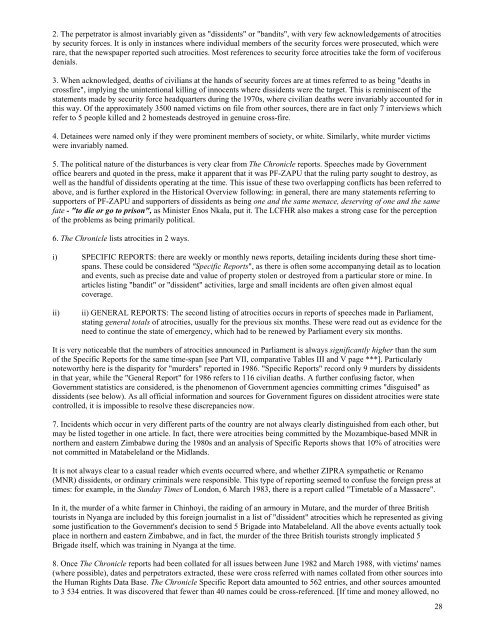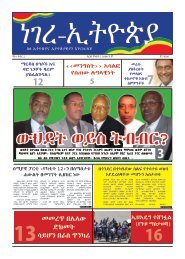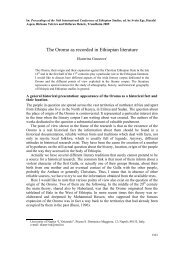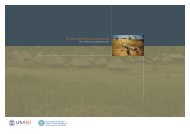MatabelelandReport
MatabelelandReport
MatabelelandReport
Create successful ePaper yourself
Turn your PDF publications into a flip-book with our unique Google optimized e-Paper software.
2. The perpetrator is almost invariably given as "dissidents" or "bandits", with very few acknowledgements of atrocities<br />
by security forces. It is only in instances where individual members of the security forces were prosecuted, which were<br />
rare, that the newspaper reported such atrocities. Most references to security force atrocities take the form of vociferous<br />
denials.<br />
3. When acknowledged, deaths of civilians at the hands of security forces are at times referred to as being "deaths in<br />
crossfire", implying the unintentional killing of innocents where dissidents were the target. This is reminiscent of the<br />
statements made by security force headquarters during the 1970s, where civilian deaths were invariably accounted for in<br />
this way. Of the approximately 3500 named victims on file from other sources, there are in fact only 7 interviews which<br />
refer to 5 people killed and 2 homesteads destroyed in genuine cross-fire.<br />
4. Detainees were named only if they were prominent members of society, or white. Similarly, white murder victims<br />
were invariably named.<br />
5. The political nature of the disturbances is very clear from The Chronicle reports. Speeches made by Government<br />
office bearers and quoted in the press, make it apparent that it was PF-ZAPU that the ruling party sought to destroy, as<br />
well as the handful of dissidents operating at the time. This issue of these two overlapping conflicts has been referred to<br />
above, and is further explored in the Historical Overview following: in general, there are many statements referring to<br />
supporters of PF-ZAPU and supporters of dissidents as being one and the same menace, deserving of one and the same<br />
fate - "to die or go to prison", as Minister Enos Nkala, put it. The LCFHR also makes a strong case for the perception<br />
of the problems as being primarily political.<br />
6. The Chronicle lists atrocities in 2 ways.<br />
i) SPECIFIC REPORTS: there are weekly or monthly news reports, detailing incidents during these short timespans.<br />
These could be considered "Specific Reports", as there is often some accompanying detail as to location<br />
and events, such as precise date and value of property stolen or destroyed from a particular store or mine. In<br />
articles listing "bandit" or "dissident" activities, large and small incidents are often given almost equal<br />
coverage.<br />
ii)<br />
ii) GENERAL REPORTS: The second listing of atrocities occurs in reports of speeches made in Parliament,<br />
stating general totals of atrocities, usually for the previous six months. These were read out as evidence for the<br />
need to continue the state of emergency, which had to be renewed by Parliament every six months.<br />
It is very noticeable that the numbers of atrocities announced in Parliament is always significantly higher than the sum<br />
of the Specific Reports for the same time-span [see Part VII, comparative Tables III and V page ***]. Particularly<br />
noteworthy here is the disparity for "murders" reported in 1986. "Specific Reports" record only 9 murders by dissidents<br />
in that year, while the "General Report" for 1986 refers to 116 civilian deaths. A further confusing factor, when<br />
Government statistics are considered, is the phenomenon of Government agencies committing crimes "disguised" as<br />
dissidents (see below). As all official information and sources for Government figures on dissident atrocities were state<br />
controlled, it is impossible to resolve these discrepancies now.<br />
7. Incidents which occur in very different parts of the country are not always clearly distinguished from each other, but<br />
may be listed together in one article. In fact, there were atrocities being committed by the Mozambique-based MNR in<br />
northern and eastern Zimbabwe during the 1980s and an analysis of Specific Reports shows that 10% of atrocities were<br />
not committed in Matabeleland or the Midlands.<br />
It is not always clear to a casual reader which events occurred where, and whether ZIPRA sympathetic or Renamo<br />
(MNR) dissidents, or ordinary criminals were responsible. This type of reporting seemed to confuse the foreign press at<br />
times: for example, in the Sunday Times of London, 6 March 1983, there is a report called "Timetable of a Massacre".<br />
In it, the murder of a white farmer in Chinhoyi, the raiding of an armoury in Mutare, and the murder of three British<br />
tourists in Nyanga are included by this foreign journalist in a list of "dissident" atrocities which he represented as giving<br />
some justification to the Government's decision to send 5 Brigade into Matabeleland. All the above events actually took<br />
place in northern and eastern Zimbabwe, and in fact, the murder of the three British tourists strongly implicated 5<br />
Brigade itself, which was training in Nyanga at the time.<br />
8. Once The Chronicle reports had been collated for all issues between June 1982 and March 1988, with victims' names<br />
(where possible), dates and perpetrators extracted, these were cross referred with names collated from other sources into<br />
the Human Rights Data Base. The Chronicle Specific Report data amounted to 562 entries, and other sources amounted<br />
to 3 534 entries. It was discovered that fewer than 40 names could be cross-referenced. [If time and money allowed, no<br />
28







